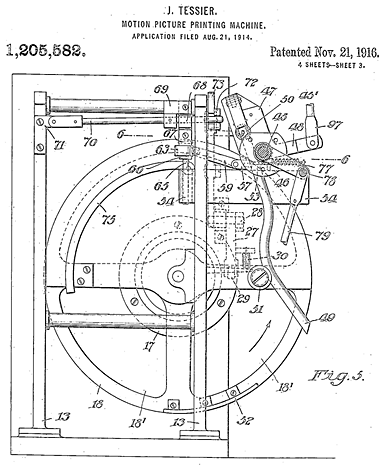The Studio
Tour the Betzwood Studios
Betzwood Patents
 Siegmund Lubin kept a number of engineers and designers on his payroll to provide his company with new and innovative technology in the rapidly changing motion picture industry. Many of their inventions received patents and the devices and machines were in use at the Betzwood studio. Of the names mentioned in the patent specs below, Julien Tessier and Lodewyk Holst continued to work in the industry for decades after Betzwood closed.
Siegmund Lubin kept a number of engineers and designers on his payroll to provide his company with new and innovative technology in the rapidly changing motion picture industry. Many of their inventions received patents and the devices and machines were in use at the Betzwood studio. Of the names mentioned in the patent specs below, Julien Tessier and Lodewyk Holst continued to work in the industry for decades after Betzwood closed.
1. Motion picture film (This innovation was never actually used)
2. Film cleaning and polishing mechanism
8. Magazine film holder for cameras
9. Tripod head
Betzwood Studios
 The Betzwood studio utilized a string of nineteenth century buildings which brewer John. F. Betz had built along the Pennsylvania Railroad line that ran through his estate. With the assistance of his son-in-law, Ira M. Lowry, and company engineer, Edward L. Simons, Lubin had each structure repurposed for the studio’s use.
The Betzwood studio utilized a string of nineteenth century buildings which brewer John. F. Betz had built along the Pennsylvania Railroad line that ran through his estate. With the assistance of his son-in-law, Ira M. Lowry, and company engineer, Edward L. Simons, Lubin had each structure repurposed for the studio’s use.
In this view, the house at the far left became the office building with direct phone lines to the Philadelphia studio. (The Betzwood train station would be to the left of this building and out of the picture. The site of this former station would be under the Betzwood Bridge today.)
The next building contained the power plant for the studio, and the next structure to the right held a cafeteria where studio employees got their free hot lunches. The food service also prepared the sandwiches and coffee given out to the hundreds of extras who came to the studio grounds to appear in Civil War battle scenes.
A bit further to the right, and seen through the water tower, was the film processing plant, the largest building on the studio grounds. It had a capacity of nearly five million feet of finished film per week. This was one of the most technologically advanced film plants I the world in its day. It was fully air conditioned and, since each stage of the developing and printing processes required different conditions, each room had separate temperature and humidity settings. All of the machines were under Lubin’s own patents and, over the years that the studio operated, Lubin’s technicians continued to devise and patent more equipment for the studio’s use.
The last building on the right provided scenery storage on the upper level and a stable for the cowboy’s horses on the bottom floor. Both the processing plant and the scenery/stable building are still standing today along the bike path that replaced the railroad right of way some years ago.
The Betz mansion stood on the hill just beyond this row of structures but can not be seen in this photo because of the plume of steam and smoke from a train passing behind the buildings on its way to Philadelphia.
Facing these buildings just a short distance away were the daylight and “dark” studios Lubin had constructed for filming his Betzwood movies.
Mapping the former Betzwood Studios
The Betzwood Studios property consisted of two farms which were simply referred to as “Farm #1” and “Farm #2” (color coded accordingly). Click on the icons to see the location of the various buildings on the property. Zoom controls are in the upper left. Switch to map or other views on upper right. Explore the full-sized map with key on Google Maps.
